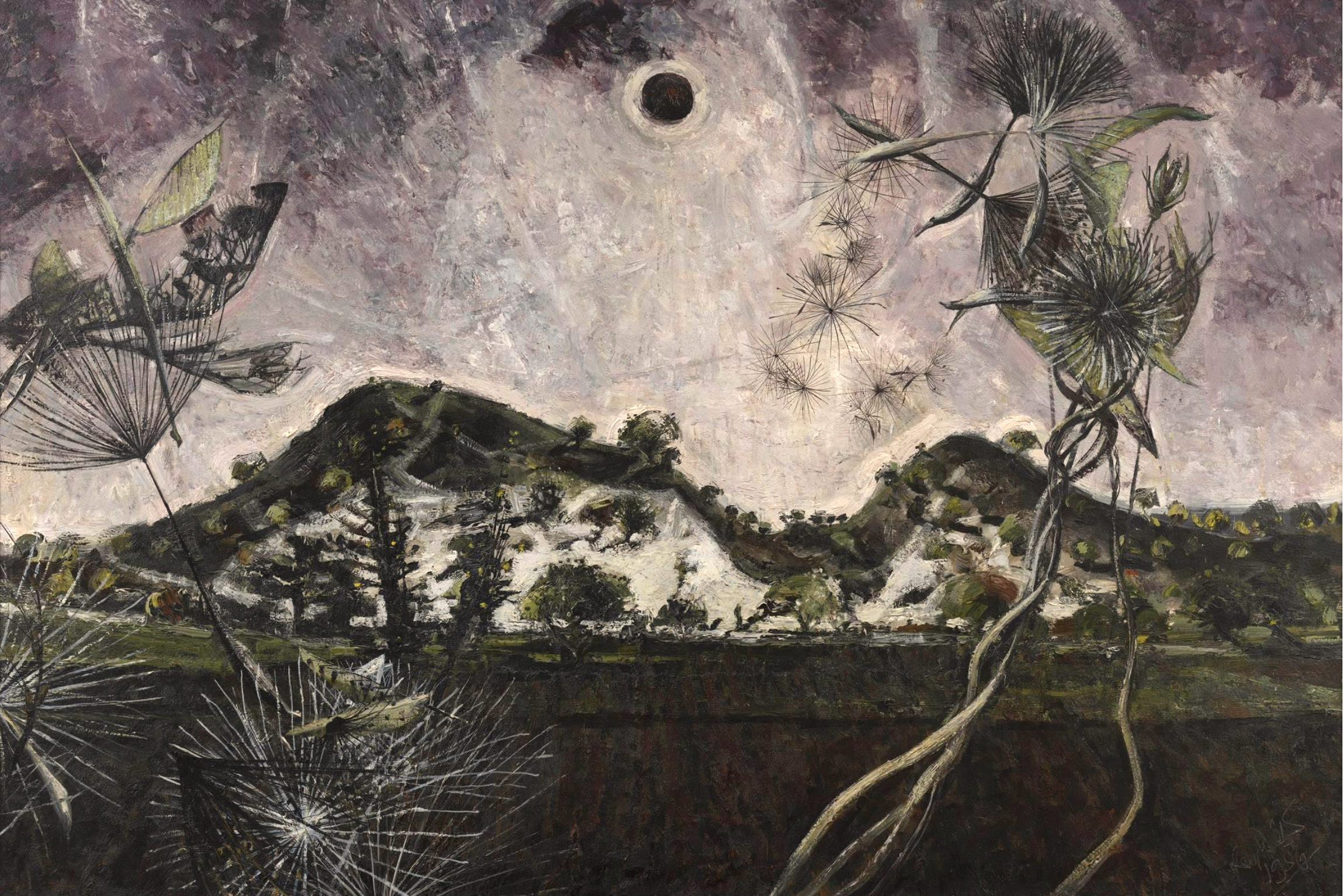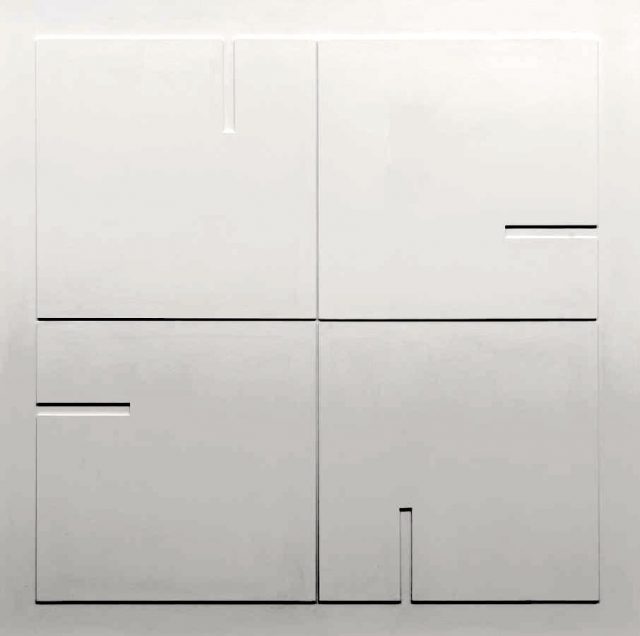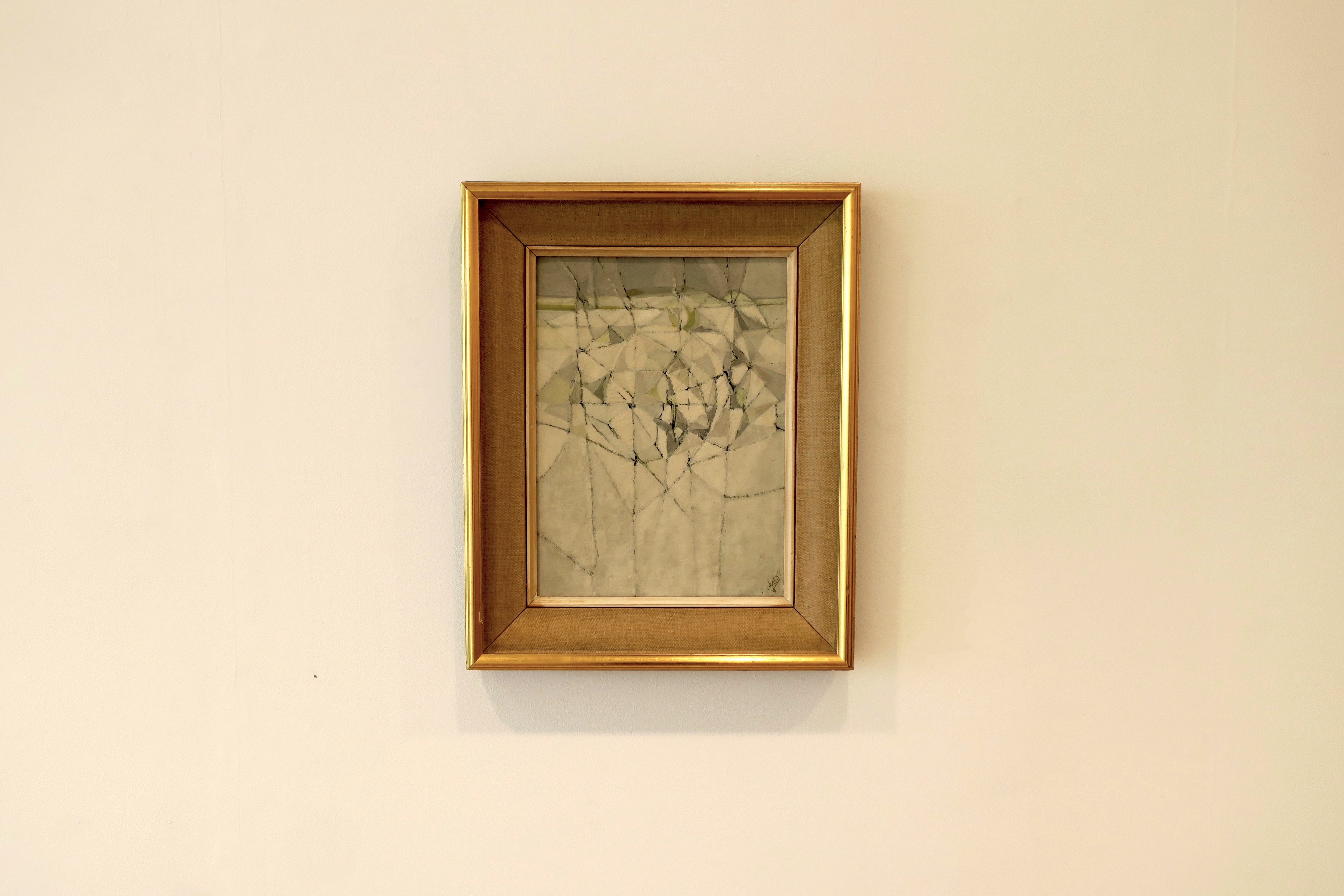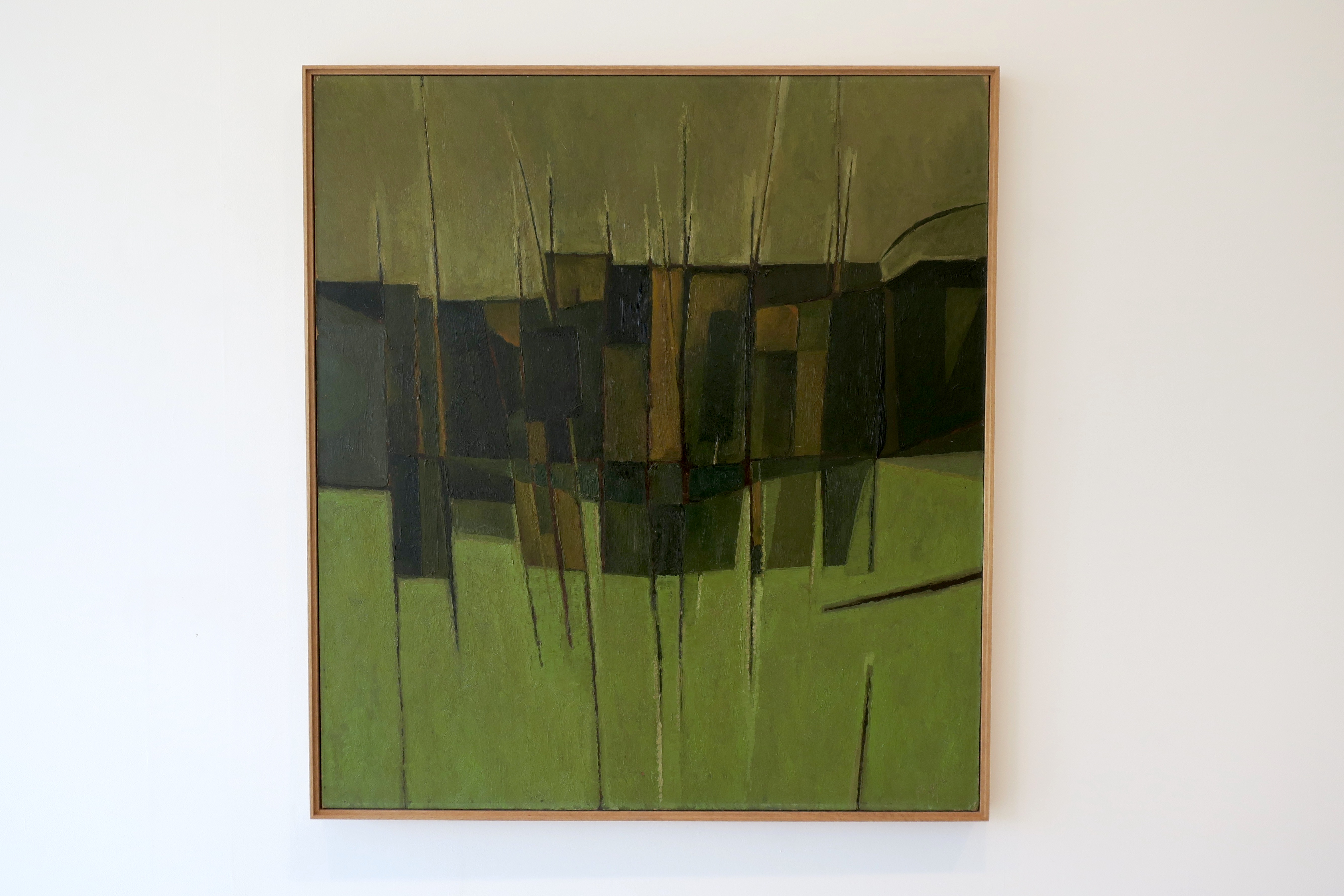I love the Annely Juda Gallery very much. I’ve been visiting as long as I’ve lived in London and it always feels like I’m coming home. I first knew it as a small warehouse space in Tottenham Mews, next-door to the Angela Flowers Gallery. It was all scrubbed floorboards and whitewashed walls hung with jewel-like fragments of Bauhaus, De Stijl and Russian Constructivist art. Most exhibitions seemed to be called The Non-Objective World and they were always a great education in abstraction. In 1990 she moved to Dering Street where I first discovered the work of Eduardo Chillida, and saw an exhibition of minimal white reliefs by Alan Reynolds. It was a revelation.
I knew his earlier work from a friend who had one of his paintings from the 1950s, not this one but very similar, a landscape with a spiky thistle in the foreground. His early work seemed related to Graham Sutherland and through him to Samuel Palmer, but I hadn’t realised how over the years his subject matter had become so radically reduced, until ultimately he was painting only pure essences.
Structures – Group IV (No.31) Rotation (2013)
This time round I knew more what to expect, but there were still surprises.
The Poet Goes Poaching (1951)
There’s something about this little painting that makes me think of Cecil Collins, but for Michael Harrison it recalled Paul Klee.
AR’s ‘The Poet Goes Poaching’ of 1951, which still hangs in his home as a kind of talisman, certainly looks to the ‘figurative, poetic, mysterious’ aspect of Klee, which he continues to delight in. It is one of a number of nocturnal scenes from that time, though the only one with a figure. But a year or two earlier in 1949 or ’50 he had made a copy and six or seven related studies (all since destroyed) from the tipped-in reproduction of Klee’s Nocturnal Festival in the Herbert Read Faber Gallery book. Beyond the enchantment of its starlit darkness, he discovered an approach to composition which served as a guiding light through the landscape years of the 1950s to the abstract paintings of the early ’60s and on to the ‘abstract, mathematical and lucid’ – though AR downplays the extent of the maths – drawings and reliefs of later years.
Alan Reynolds – The Making of a Concretist Artist: Michael Harrison, 2011
The Village Fair (1952)
In 1952 AR painted a series of pictures where the problems of foreground extending into middleground, and middleground into background were met by wedging a frieze of farm buildings between left and right edges of the painting – something like a row of bricks which might collapse if the pressure is not maintained…
With ‘The Village Fair’ we are looking into the light and the buildings cast shadows back into the foreground from which hop poles rise, crossing the buildings and piercing the sky. Hop poles would be a recurring device, providing vertical accents, parallel with the picture plane, as they stake out a landscape of receding horizontals.
Ibid
Dark Horizons (1957)
Winter Image (1958)
Crystalline Landscape (1958)
Lyric Abstract (1958-59)
Painting a picture involves, apart from other things, the ‘Relativity of All – to the Rectangle’. It is, for me, in other words, a problem of solving equations; tonal, linear and so on. The subject or motif must be transformed and become an organic whole. Poetry is never absent from nature, but alone it cannot constitute a work of art. It must be reconciled with the elements of design and composition. Laying emphasis on the formal values in a work will therefore result in a degree of abstraction. This is, to me, the logical development of the motif towards its transformation into a picture.
Alan Reynolds in the catalogue for his 1953 Redfern Gallery exhibition
Pastoral – Green and Grey (1959)
Forms – Red, Green and Orange (1960)
Forms Polyphonic – Yellow and Black (1961)
For AR, Klee was a constant guide and irregular chequerboard compositions continued through 1960 into 1961 with such prosaic titles as ‘Structure – Red, Black and Green’, but culminating in two oil versions of ‘Forms Polyphonic – Yellow and Black’. The quest for musical equivalence, first mooted in 1953, becomes explicit: polyphonic, simultaneous sounds, instead of the sequential suggestion of a lyric structure. Light still emanates, as it had from the distant radiating sun, but now from the orthogonal structure and surface of the painting.
Alan Reynolds – The Making of a Concretist Artist: Michael Harrison, 2011
Forms – Blue, White, Green and Bronze (1961)
Of all his immediate seniors, AR still speaks with great admiration for William Scott. He must have felt a certain connection with Scott’s working and reworking his repertoire of still life subjects and his exploring of the borderland between figurative and abstract, not to mention his sheer enjoyment of paint.
In 1961-62 AR’s central band reaches up and down and comes close to Scott’s table tops with forms invading from the sides, though just forms, more or less geometric, and never with the implication of Scott’s pots and pans. A disc is now a disc, neither sun nor moon; a line is not a hop pole; a triangle is not a roof.
Ibid
A view of the third-floor gallery.
Composition with Yellow Ovoid (1965)
In 1962 AR introduced an oval format into his paintings. The oval, of course, goes back in twentieth-century art to Braque and Picasso in 1910-14, and Mondrian made it his own from 1912-13… For the Cubists, the oval had been a means of encapsulating and concentrating the almost sculptural image of the figure or still life, of helping the integration of space and solid, and of not allowing the composition to dissipate towards the corners. Braque talked of it enabling him to ‘rediscover the sense of the horizontal and vertical’. It began to break the convention of the rectangular picture as a window onto a world beyond… With Mondrian there is a conscious sense of what he saw as the male vertical and female horizontal, and the oval – the egg – suggesting spiritual rebirth. While the man-made pier, of the ‘Pier and Ocean’ drawings, juts into the formless or fluid sea. Mondrian has replaced any three-dimensional illusionism with a two-dimensional fusion of matter and spirit.
Ibid
Structure – Ovoid Ground (1962)
AR recalls the first ovoid painting coming quickly, within a week, before any of the studies and gouaches, with the corners being eliminated quite instinctively to counterpoint the horizontals and verticals. The oval immediately dispensed with the straining – the pushing and pullings, up and down, from side to side – of the rectangular compositions. Finally he was freed from the implications of landscape, from the bottom of the painting being earthbound and the top the far distant sky. Instead, he seemed to be exploring a more cosmic, gravity-free space.
Ibid
Structure – July (1964)
The ovoid paintings may or may not have been inspired by the television testcard.
We left the third-floor and climbed the stairs to the fourth-floor gallery…
and entered a new era.
Quartet – Blue Disc (1975)
In a quandary to know which way to turn in his own work, he embarked on a period of two years’ printmaking, experimenting with etching and aquatint but, most fruitfully, with linoprint. Instead of carving into the lino, he cut shapes as silhouettes and mounted them on wood, composing and recomposing them in different configurations. From this he saw the possibility of working with the shapes themselves and began to construct reliefs.
Ibid
Dialogue (1973)
Horizons had disappeared with the freedom of moving shapes across a format but in 1972, at the beginning of a series called ‘Dialogue’, the curves of two differently coloured semicircular discs touch across a vertical divide. Now the board has become an active player rather than just the backdrop or container for shapes and soon the board is also halved horizontally, creating four quadrants in altogether more formal compositions. AR was not to know it but he had laid the foundations for almost forty years work to come.
Ibid
Dialogue (1973)
White Relief (1966)
Relief (1962)
Study for ‘Structures Group II (T)’ (1981)
Structures Group II (T) (1981)
Study – Rotation 129 (2013)
Structures Group IV (No.31) Rotation (2013)
For fifty years he has been an abstract or ‘concrete’ artist. In 1967 he abandoned painting entirely and began to make constructed reliefs, and for the last thirty years he has made only white reliefs, tonal drawings and woodcuts.
Ibid
Structures – Group IV (No.31) Rotation (2013)
After an earlier visit to a previous exhibition of all-white reliefs, my friend Olivia (owner of the thistle painting) spoke of visions of floaters and flashes in her field of vision, of this gallery as a light-box, a space for intense looking, both inside and outside the eye. It’s the best place to absorb these pictures.
Rotation A, B, C, D (2005)
Drawing 77 (1977) x 2
Alan Reynolds | A Small Retrospective: Works From 1951-2014
※
For Alan Reynolds 1926-2014 & Michael Harrison 1947-2013.









































Alan Green taught at Ravensbourne when I was an undergraduate student there. I first saw his paintings and etchings at Annely Juda’s gallery. I always thought that it was a proper serious place, but welcoming too.
Yes, I saw many Alan Green shows there too. Beautifully tailored, deep and rich and the embodiment of gravitas.
oh, so wonderful, the writing and the artist, and the art, and the progression through time .. and i always wonder, did his art pay for his habit of making art?